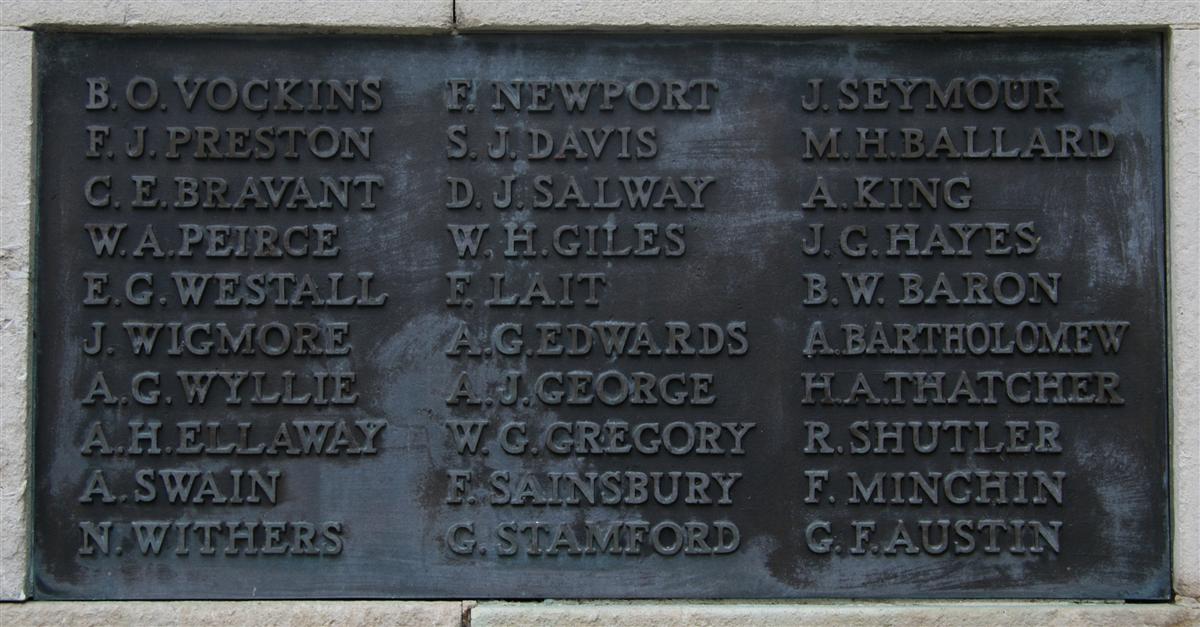William Herbert Giles
Gunner 191031 William Herbert Giles, 223rd Anti-Aircraft Section, Royal Garrison Artillery
William was born in Newbury on 6 September 1897 and was christened in the parish church of St Nicolas on 7 November. He was the son of James Giles, a bricklayer, and his wife Martha (née Admans). His elder sister was May Rosina (born 1896) and the third and final sibling was Stanley Edward (1899). However, this was not all of the family, there was an older boy, Reginald Giles Admans, who was born and died in 1895, almost certainly another of the couple’s offspring predating their marriage by a few months. Then there were James’ children from his previous marriage to Martha’s sister Jane; they were: Elizabeth Ann (1885), Sarah (1886), Martha Nellie (1887), Frederick George (1890), Edith Mary (1891) and Henry James (1893). Sarah also died in childhood in 1900, aged four.
 Newbury Grammar School - design drawing from 1881, merged with Newbury Girls School and is now St Bartholomew's School in a new building |
William was conscripted, attesting for service on 5 June 1916. However, he did not have to serve in uniform until 31 October. The Army could not cope with all the men of conscriptable age at once so they signed them up and immediately posted them to the Reserve, this meant that the man could go back to his civilian existence, but was a serving soldier, subject to a short notice call up at the Army’s convenience. His attestation included a medical, which gives some idea of his appearance: he was 5ft 7½ins tall with grey-blue eyes and brown hair.
On 1 November William was sent to No 3 Depot, Royal Field Artillery (RFA) at Hilsea for training. After basic training to instil discipline men would receive specialist training according to their abilities. As an artilleryman one might anticipate training as gun crew, and William will almost certainly have learnt how to load, aim and fire a gun, but there was another highly valued skill needed in the artillery – that of signalling. Reading flag signals, understanding Morse code transmitted by wire, sound or light and sending such signals was far more complex than basic gun management. William was trained in this role and, in March 1917, was posted to 3rd Reserve Brigade RFA HQ as a signaller.
The following month there was bad news from home, his father, James, died on 6 April of gastritis and heart disease.

The cap badge of the Royal Artillery - used by the RFA and RGA. |
He remained in anti-aircraft batteries until the end of the war and beyond.
He died on 7 February 1919 at the 3rd Canadian General Hospital, Boulogne; the cause of death was given as broncho-pneumonia. There is no record of his admission to hospital but death from pneumonia was sadly commonplace at this time as it was the secondary infection that killed most of the millions of victims of the deadly influenza epidemic known as the Spanish Flu.
The news quickly reached Newbury:
Newbury Weekly News, 7 February 1919 – Deaths
GILES. – February 7th, at 3rd Canadian General Hospital, Boulogne, Gunner William Herbert Giles, the dearly loved son of the late James and Mrs Giles, of 6, Kingsbridge Road, aged 21.
He was buried in grave XIII.C.9 at Terlincthun British Cemetery on the outskirts of Boulogne.
 William's name on Newbury War Memorial. (upper centre) |
Locally he is remembered on tablet 4 of the Newbury Town Memorial and on the splendid memorial board commemorating lost members of the Newbury Congregational Church (now located in Newbury Town Hall). It has also been suggested that his name is recorded on the Newbury Grammar School Memorial as L Giles – as he was a fallen old boy his name should be there and there is no record of an L Giles having attended the school.
Brothers
William’s brothers were also of an age to serve in the war.
His eldest brother, Frederick George, emigrated to Australia in 1911 and died there in 1959. There is no record of his enlistment during the war. Australia never introduced conscription so there was no compulsion to serve.
 Henry in uniform, |
Henry is listed on the Hungerford Roll of Honour that commemorates the service of the survivors as well as the fallen. He volunteered and served as a Private in the Royal Berkshire Regiment (No 16471) and was sent to France in August 1915 as a replacement for the 6th Battalion. He also served in the regiment’s 2nd and 5th Battalion, which suggests that he may have been wounded (breaks in service caused by wounds are a common explanation for a change of battalion). Nevertheless, he survived the war, returned home, married and raised a family before dying in 1978 aged 85.
Stanley Edward, William's only full brother turned 18 in 1917 and was soon conscripted beginning his service on 18 July. He never left the UK spending his time with the 52nd Graduated Battalion of the Royal Warwickshire Regiment – a training battalion. He evidently showed some promise since he was an Acting Corporal when he was discharged on 25 April 1919.

Find a memorial :
| Died this day: | |
| 29 November 1918 | |
| Richard Vincent Sutton | |
| Stockcross |

Like this site? Show your appreciation through a donation to a great charity.